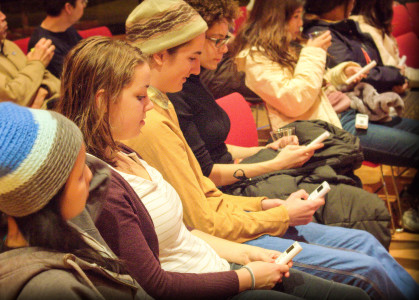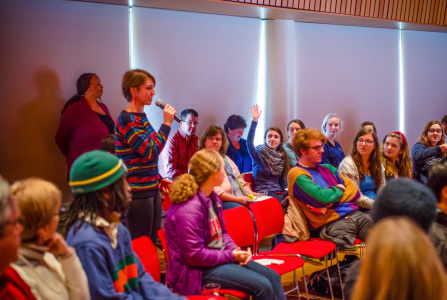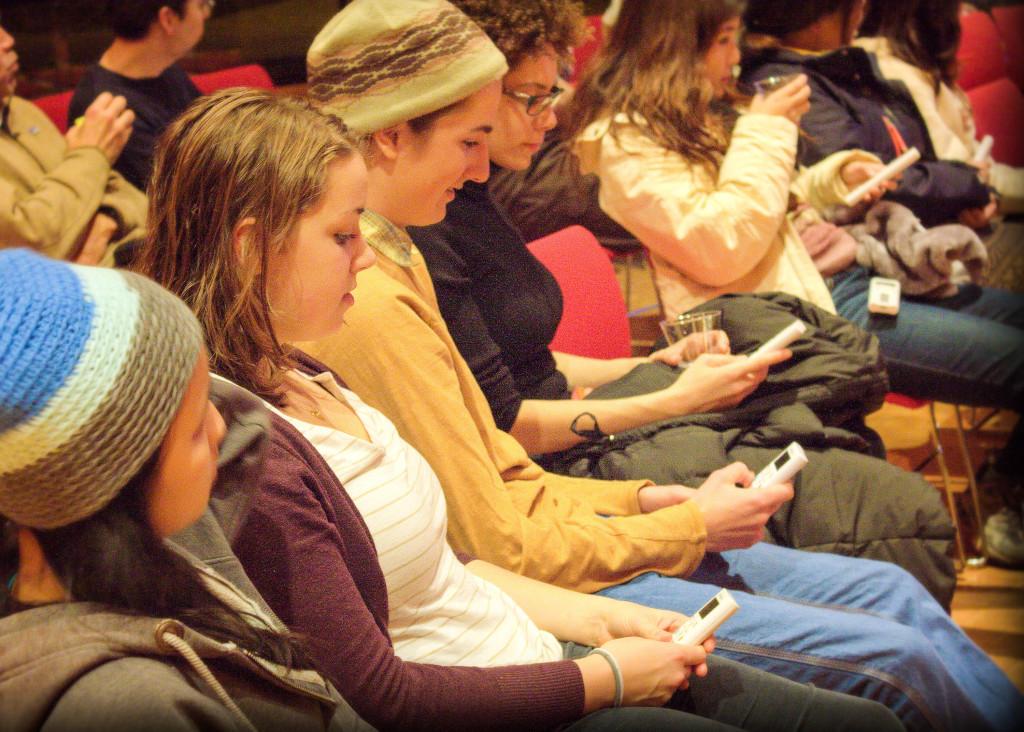On Thursday, Nov. 13, Grinnell held the third and final town hall of the 2014 fall semester at noon and 7:30 p.m. in JRC 101. Students, faculty and staff in attendance focused on campus sustainability, which is a particularly relevant choice given the recent decision to expand ARH and Carnegie and the rejection of a previously proposed plan to build a college wind turbine.

Photo by Megan Pachner.
The evening session of the town hall was more intimate than the noon session, as 30 or so Grinnell students and faculty members were alongside members of the community, employees of the College’s dining services and President Raynard Kington. SGA President Opeyemi Awe ’15 as well as Environmental and Safety Manager Chris Bair and Professor Liz Queathem, Biology, facilitated the discussion. Awe stated that this town hall is particularly timely because it is difficult to stay up to date on the conversation regarding sustainability at Grinnell.
“Sustainability is a topic that many people are interested in but underinformed about. We hope this town hall can provide some of that missing information,” Awe said.
Queathem and Bair also provided a presentation to accompany their discussion. They highlighted the issues of energy, food, building renovation and water conservation as the main areas where Grinnell should improve sustainability on campus.
Queathem mentioned that Alliant Energy, Grinnell’s main source of energy, has a questionable method of cultivating energy.
“The energy provided from Alliant Energy comes from coal power plants—which we all know are very dirty,” Queathem said.
Questions of sustainable food options on campus were geared towards how to achieve both the local and the humane, particularly with meat products. In Iowa, a lot of livestock is raised in large-scale CAFOs, an act that many have alleged prevents the humane farming of animals.
“We are reaching for products both sustainably farmed and humanely raised,” Queathem said.
The point on new buildings and renovations is also a reflection of the conversations surrounding how sustainable the expansion of ARH and Carnegie will ultimately be. Queathem pointed out that total size of the two buildings has increased since 1988, which has resulted in an increase in the associated amount of greenhouse gas emissions. In order to curb this growth, it is pertinent for students to become active in the conversation regarding the building expansion, Queathem said.
With regards to water conservation, Queathem pointed out that Grinnell’s reliance on Iowa’s Jordan Aquifer means that the College is reliant upon fossil water, or old water that cannot be replaced. Consequently, water is consistently pumped out of the aquifer much more rapidly than it can be replaced. In lieu of this system, the presenters proposed utilizing different sources of water, such as recycling from the abundance of rainwater that Grinnell receives.
The question of landscape sustainability was a major focal point of the night’s meeting. For example, a number of Grinnellians voiced concerns about the wastefulness of non-perennial plants and the lush green grass replacing the traditional prairie ecosystem. Liza Morse ’15, chair of the Student Environmental Committee, expressed her concern about introducing prairie lands on campus.

Photo by Shadman Asif.
“One of my main concerns with the implementation of prairie on campus … is that a college community is a constantly changing organism … it has an interesting implication for landscaping because the high turnover rate of people on campus means that no one wants to be the ones who have to wait it out while the campus is beautified for future students,” Morse said.
Morse and other students stressed the need for patience in the process of landscape sustainability.
“Prairie isn’t about instant gratification, it is about patience, and that is something that the administration as a more lasting entity needs to have if we are going to see prairie successfully implemented in the face of pressure for instant aesthetic gratification,” Morse added.
Bair spoke on behalf of some of the changes Grinnell has made, such as working with Alliant Energy to create building audits, installing LED lighting across campus and renovating dorms to include things such as new triple pane windows and LED lighting, and submetering. These changes are what many Grinnell hope to continue and expand upon.
Further, Awe added that in order for the community to advance sustainability on campus, it is important for everyone to do a part.
“Sustainability is something we all have a part in doing and all the little actions we do help,” Awe said.
























































